Uncovering the Joys of Urban Parks: The Green Lungs of Our Cities

Introduction to Urban Parks
Amidst the high-rise buildings and sprawling urban sprawl lie the sanctuaries of greenery known as urban parks. These pockets of tranquility add aesthetic value to our cities and serve as critical communal spaces for recreation, relaxation, and congregation. In these verdant havens, the efforts of residential landscape design services North Carolina shine as they artfully integrate natural elements into our everyday environments. Blending tree canopies, shrubbery, and open spaces invites city dwellers to pause, rejuvenate, and connect—offering a precious balance to the otherwise fast-paced urban lifestyle.
The intrinsic value of urban parks has been recognized for centuries, yet only in recent decades have their role been truly reimagined. Gone are the days when these parks were merely visual breaks from the monotony of urban architecture; they now embody the ecological soul of a city, providing environmental benefits that ripple out far beyond their boundaries. Through the years, urban parks have matured into spaces as dynamic and diverse as the cities they serve, reflecting cultural values, conserving nature, and enhancing the urban experience for all inhabitants.
The Benefits of Urban Parks to Our Health
The impact of urban parks on public health is undeniable. Access to natural spaces within cities is directly linked to improved physical fitness, as these parks encourage active lifestyles through various outdoor activities. From children gleefully playing on the grass to adults engaging in jogging or yoga sessions, urban parks provide an inviting setting for exercise. However, the benefits of these areas also have profound psychological implications—the serene backdrop of an urban park is an antidote to the stress and sensory overload often associated with city living, offering a haven of calm and restoration for the mind.
Urban parks play a vital role in mental health promotion and stress reduction. Studies point to the positive effects of nature on cognitive function, emotional well-being, and overall psychological health. Spending regular time in green places has been reported to reduce levels of anxiety, depression, and mood disorders in individuals. Furthermore, they are catalysts for community wellness, as social interactions in these settings help foster a sense of belonging, reduce loneliness, and promote a shared identity among urban residents.
Design and Planning Considerations for Urban Parks
Urban parks’ thoughtful design and planning can profoundly influence their success and utilization. Landscape architects and urban planners are tasked with creating these green spaces to be functional, sustainable, and adaptive to the needs of diverse urban populations. Factors such as the selection of plant species, the configuration of walkways, and the provision of amenities such as seating, lighting, and water features are fundamental in shaping enjoyable and accessible park experiences. These designs must also address environmental sustainability, incorporating eco-friendly practices such as water conservation, using native plants, and promoting local fauna.
Innovations in the field of landscape architecture have contributed to the creation of more engaging and interactive urban parks. Advances in sustainability have guided the inclusion of rain gardens, permeable pavements, and eco-friendly maintenance practices that enhance the ecological performance of these spaces. The design process also takes accessibility and user experience into account, guaranteeing that parks are inclusive places for people of all ages and abilities.
Urban Parks and Community Engagement
The vibrancy of urban parks often reflects the community’s involvement in them. These natural spaces provide a canvas for a broad spectrum of community activities and initiatives that foster engagement and stewardship. From organized clean-up days to cultural festivals, parks offer myriad opportunities for residents to connect with their environment and each other. Volunteer programs, gardening clubs, and “friends of the park” groups are just a few examples of how community members can contribute to the upkeep and development of these public spaces.
Events and programs in urban parks promote a strong sense of community and provide a platform for local voices and talents. Such engagement directly contributes to the parks’ success by cultivating a vested interest in their maintenance and improvement. This active participation is critical to sustaining urban parks’ social and environmental health, creating a ripple effect that benefits entire city ecosystems.
Educational and Cultural Aspects of Urban Parks
Beyond their recreational role, urban parks often serve as centers for education and cultural enrichment. They can be living classrooms that teach about local ecology and the environment, hosting educational activities, nature walks, and interactive stations designed to engage young minds and promote environmental stewardship. Through such experiences, visitors of all ages can learn about preserving natural habitats, understanding the local ecosystem, and the measures necessary for maintaining urban biodiversity.
Cultural events and art in parks celebrate the heritage and diversity of the community. They provide space for performances, exhibits, and festivals that showcase the rich tapestry of urban life. By hosting these cultural activities, urban parks reinforce their role as essential public spaces that are beneficial for health and well-being but also central to the cultural vitality of cities.






